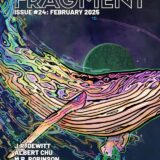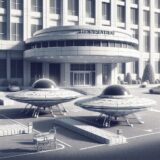
I first heard about Simon Stålenhag from my wife, the Beautiful & Talented Lynne Taylor Fahnestalk, several years ago. She pointed me to some paintings she’d seen online, like this one, many featuring dead and abandoned giant war machines in a pasture, or Swedish snow scenes with giant electronic towers in the background (this one’s called “Dusters”):

These realistic-looking pictures were unlike anything we’d seen before (You can find some of those at this site. Just click the link.)
Then, a couple of years back, a TV show based on Simon’s work, Tales from the Loop, came out. Although it was uneven in execution, both script and visuals, it gave promise that soon we’d see something even more extraordinary from Stålenhag. Obviously, as an artist, he kept producing more artwork—from books to music—and wrote stories to tie the pictures together, which led to The Electric State, the graphic novel-type book this film is (loosely, according to Wikipedia) based on.

I haven’t read the book, and so can’t comment on how faithful the film is to the book; but Anthony and Joe Russo bought the film rights and, with the assistance of Netflix and a whole host of people, turned the book into a Netflix movie, about a young girl and a small robot navigating a world like our own, but one where robots warred against their creators and lost, thus being exiled to the wastelands of the Southwestern United States.

Since I haven’t read the book, I must review the movie on its own merits. The main characters vary between human, like Millie Bobby Brown (Stranger Things, Enola Holmes) as Michelle; Chris Pratt (Parks & Recreation, Guardians of the Galaxy, Jurassic World) as Keats; Stanley Tucci (Conclave, The Hunger Games, The Lovely Bones) as Ethan Skate; Giancarlo Esposito (Breaking Bad, The Usual Suspects, Do the Right Thing) as The Marshal/Colonel Bradbury; and Jason Alexander as Ted, Michelle’s foster father and Holly Hunter as a TV personality; and CGI characters voiced by actors, like Woody Harrelson, Alan Tudyk and others. It’s a heck of a cast, and one would expect a movie based on Stålenhag’s work by the Russo Brothers, something like 50% CGI, and with such a cast would be a blockbuster.

Boy, I wish it had been so. The visuals are, as one would expect, terrific. If you compare Figure 2, an original painting by Stålenhag, with figure 5, a still from the movie, you can see how well they’ve translated the visuals. But as is usual with modern SF films, there should be more to a film than just the visuals; there are such things—you’d never know it sometimes in this film—as plot, character, pace, and so on. As far as I can tell, the best-developed character was Michelle (Brown), with a fairly consistent character arc; followed by The Marshal (Esposito), who had a very abrupt change to his character—it was sort of an arc. Both Skate (Tucci), the putative “bad guy,” and Keats (Pratt), the smuggler, were either woefully undeveloped or just “there,” like Christopher (Woody Norman) (, the supposedly comatose brother whose mind was inside Cosmo, the robot. The best secondary charcter was probably Mr. Peanut (Woody Harrelson) or maybe Herman (Anthony Mackie), Keats’s robot sidekick.
The plot goes something like this: Walt Disney developed animatronics (Hey, I’ve been to the Hall of the Presidents at Disneyland) which eventually developed into robots, which became mass-produced and began taking all the crap jobs humans didn’t want to do. Robots eventually rebelled—where have I heard this before? No, it doesn’t make more sense now than it has in the past—and warred on their human masters. A company called Sentre (pronounced “center”), run by Stanley Tucci channeling Steve Jobs (clothing and attitude) and Bill Gates (mind), invented this “Neurocaster” helmet, which allowed humans to control lots of drones, thereby causing the robots to sue for peace. The surviving robots were expelled to an “Exclusion Zone” that humans were forbidden to set foot in; humans started using the Neurocaster to control drones doing all the work while at the same time enjoying their leisure time using some kind of “split brain” technology. No, it didn’t make a lot of sense to me either. But the bots (all the world’s bots?), with their putative leader being “Mr. Peanut,” (Woody Harrelson) Planters’ robot spokesman, signed a treaty to be confined to the 40,000 acre Exclusion Zone.
Christopher, Michelle’s younger brother, was supposedly a genius surpassing Einstein—he aced in a couple of hours a test that took Einstein three days—but he and Michelle’s parents were supposedly killed in a car accident involving a deer. He had previously told Michelle about quantum entanglement and said that since we all exist in an electric state (whatever the heck that means), he and she were linked. But as a ward of the state, she was forced to wear an ankle monitor to keep her from escaping from Ted (Jason Alexander), her latest foster father. She was a rebellious teen and refused to wear a Neurocaster in school, so when Cosmo, the little robot based on a popular TV cartoon, indicated to her that it was in fact her brother (quantumly entangled), she ran away with it/him, stealing Ted’s car.
Eventually, she meets Keats (Pratt), who was the smuggler scouring the wasteland for collectables (Ted had bought a lot from him) to sell, and his robot sidekick and best friend, Herman (Mackie). But she and Cosmo are somehow tracked, despite losing the ankle bracelet, by The Marshal (Giancarlo), who was famed for being the best robot-killer of the 1990s war between the bots and humanity.
Are you getting all this? I’m willing, for the sake of the story, to put up with a lot of bulldooky in the setup, like the humans vs. the mutants in the Marvel movies. The story and characters, no matter how unlikely, can distract you from a lot of nonsense—don’t get me started on how Marvel’s mutation scenario works (or doesn’t), but there’s no real story in this one; it’s basically a road picture that can’t decide whether it’s serious or comedic. And why would you invest billions of dollars to build robots with brains and personalities to, for example, break boulders, or deliver milk? There’s a televised sequence where a robot accuses a man who wants to turn off a faulty toaster of murder. This isn’t Red Dwarf; why would a toaster need a brain? Just so it can revolt? And building zillions of drones so people can use their split brains to control the drones while being “in Las Vegas with Cindy Crawford” (Ted) sounds both extreme and expensive.
I could go on, and on, and on… but you get the picture. Outside the visuals, there’s no story here (or characters) that one can get interested and involved with. I guess I’d have to go with John Lennon on this one: “Turn off your mind, relax, and float downstream….”
If you’d like to say something about this column, you can comment here or on Facebook, or even by email (stevefah at hotmail dot com). All comments are welcome, but please be polite.) My opinion is, as always, my own, and doesn’t necessarily reflect the views of Amazing Stories or its owner, editor, publisher or other columnists. See you next time!










